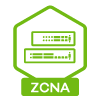How to achieve better roaming with two NWA50AX APs
Hello!
Before I explain details, one point should be put clearly: I am asking about standalone (non-cloud) solutions. Please, do not elaborate about Nebula-solutions. I know about them, but are not going to use them. Reasons below.
I have two NWA50AX APs, each connected to separate switch. The switches of both APs are connected directly to each other.
In general, I am very satisfied with the APs, however one feature, which originally led to purchase of them, has still not been achieved. Roaming between the APs is still not really fast. The only improvement of roaming, achieved by using NWA50AX is caused by newer hardware and better architecture, when compared to my old setup. I still have no benefit of 802.11k/v/r.
I have read that functionality described in 802.11r may be achieved only when using Nebula. Is this still the case? Is Zyxel going to make it available to the standalone setups in any future?
Regarding 802.11k/v, I understand that it may be achieved standalone only when the other switch is on the list of Ethernet Neighbors, this means that both APs must exchange LLDP packets. This is not possible in my case, not even if it had been possible to connect both APs to one switch. My switches are managed ones, and they have no option of forwarding LLDP packets. This is in-line with LLDP specification, so no blame to the switches.
So, no 802.11k/v for me, and probably for large fraction of other “non-Nebula” owners of multiple NWA50AX.
Is there any intention at Zyxel to make those options available in standalone mode? E.g. by disclosing commands necessary to do this input in the APs? Or by releasing a local tool which could do it?
I have heard that OpenWRT can do it without any AP Controller, so it should be possible.
Why I am not going to use Nebula:
I understand that transferring management of my APs to Nebula means not only opening access to my home network for this external tool. This is an active depositing of all topology and security information of my network at external server without any control. It also allows external manipulation of all those critical settings without any control. I would not be even aware, if anything gets adjusted.
With all respect to Zyxel, this is not diligent.
Additionally, I am not aware of any viable technical reason of doing so. So, pushing all that data of my tiny network through Internet to a remote server and engaging computing and storage there, looks somehow ridiculous from technical point of view.
As I mentioned, NWA50AX is a very nice device for such purpose, as mine. I hope, I can obtain a usable advice how to overcome this small last obstacle in my home WLAN!
Gienek.
Best Answers
-
Hi @Gienek ,
Fast roaming using 802.11r requires a controller role to help formulate a set of keys. However, in standalone mode, the AP does not have this controller role, making it unsuitable. This is an inherent limitation of this feature.
Both Nebula cloud mode and AP controller mode have the controller role present, so Fast roaming can be implemented in both these modes.
You can refer to this article to know more about the 802.11k/v/r:
Since standalone mode does not support 802.11r, optimal roaming can be achieved through proper AP placement and signal threshold configuration. This will ensure smooth client transitions between AP1 and AP2.
Zyxel_Judy
0 -
Hi @Gienek, personal opinions from here… Sorry I can't quote you direcly, the function has been disabled from this platform (unfortunately)
Roaming between the APs is still not really fast. The only improvement of roaming, achieved by using NWA50AX is caused by newer hardware and better architecture, when compared to my old setup. I still have no benefit of 802.11k/v/r.
Don't forget that also the client devices should be 802.11k/v/r enabled, both on network "cards" and settings! After enabling the features into the AP config page, be accurate and verify for all client devices that the option is enabled on the OS and/or available for the specified/configured SSID ; also, remember to design as "friendly" the "other" Access Point (on both sides) into (
Rogue APfeature).
After changing the setting, reboot the AP and verify that the setting survived the reboot: in some occasions I had hiccups about the fine tuning of the wireless, and the connection expired while I applied setting. Spend 10 minutes for double check might save hours of hassle later for unapplied settings.
Last but not least: remember that Wireless Ethernet is not like mobile phone connections: while wirelessly is still "unplug and replug" the wireless connector, so the roaming won't ever be like a phone call while in a car; is not designed for that.I understand that transferring management of my APs to Nebula means not only opening access to my home network for this external tool. This is an active depositing of all topology and security information of my network at external server without any control. It also allows external manipulation of all those critical settings without any control. I would not be even aware, if anything gets adjusted.
My opinion: unless absolutely necessary I won't use Nebula in any of the networks I'm going to manage; I consider a local management (on device or via controller) a necessity for every network device i buy/advise.
Nebula actually don't explicitly allow external manipulation without control; as any cloud service there's still the chance for attackers, vulnerabilities, data scraping, incident and outages.
IMVHO Nebula allows:
-better monitoring and historical data (more on that later)
-reduced-hassle for remote management
-tech support from trusted experts without being on-site or "lending" a remote controlled computer for the task
-faster and less prone to errors expansion of the setup, simply adding the device to the site and "copying" the configsHowever, I stand by your statement about lack of diligence from Zyxel.
Some Nebula-enabled APs currently do not support anymore SNMP (while older model would), so third party tools for monitoring and manage the network devices are simply no more an option (like Zabbix).
This lack of external monitoring do not allow a proper data collection, only a syslog server. And syslog is not "that" easy to search for compared to SMNP query (IMVHO).Also… the product lines are a bit confusing. NWAs, WAx/WBEs, 2-3 suffixex for every spec… trying generation after generation to "cut off" the middle range devices from the more interesting features.
I understand and share the belief for not still use Nebula, however for some user case might be a nice addon for ease the monitoring.I have heard that OpenWRT can do it without any AP Controller, so it should be possible.
I never read something like that. Please, link the page of the OpenWRT project/documentation where is stated this feature without the AP controller.
I'm asking this because the AP controller software should (sometimes is not granted) monitor on all devices the sensed interference/intensity of connection, actively tell to the "not good connected AP" to force the detachment of the low performance client. Without this kind of arrangement, no AP would behave like that for the connected stations.
0
All Replies
-
Hi @Gienek ,
Fast roaming using 802.11r requires a controller role to help formulate a set of keys. However, in standalone mode, the AP does not have this controller role, making it unsuitable. This is an inherent limitation of this feature.
Both Nebula cloud mode and AP controller mode have the controller role present, so Fast roaming can be implemented in both these modes.
You can refer to this article to know more about the 802.11k/v/r:
Since standalone mode does not support 802.11r, optimal roaming can be achieved through proper AP placement and signal threshold configuration. This will ensure smooth client transitions between AP1 and AP2.
Zyxel_Judy
0 -
Hi @Gienek, personal opinions from here… Sorry I can't quote you direcly, the function has been disabled from this platform (unfortunately)
Roaming between the APs is still not really fast. The only improvement of roaming, achieved by using NWA50AX is caused by newer hardware and better architecture, when compared to my old setup. I still have no benefit of 802.11k/v/r.
Don't forget that also the client devices should be 802.11k/v/r enabled, both on network "cards" and settings! After enabling the features into the AP config page, be accurate and verify for all client devices that the option is enabled on the OS and/or available for the specified/configured SSID ; also, remember to design as "friendly" the "other" Access Point (on both sides) into (
Rogue APfeature).
After changing the setting, reboot the AP and verify that the setting survived the reboot: in some occasions I had hiccups about the fine tuning of the wireless, and the connection expired while I applied setting. Spend 10 minutes for double check might save hours of hassle later for unapplied settings.
Last but not least: remember that Wireless Ethernet is not like mobile phone connections: while wirelessly is still "unplug and replug" the wireless connector, so the roaming won't ever be like a phone call while in a car; is not designed for that.I understand that transferring management of my APs to Nebula means not only opening access to my home network for this external tool. This is an active depositing of all topology and security information of my network at external server without any control. It also allows external manipulation of all those critical settings without any control. I would not be even aware, if anything gets adjusted.
My opinion: unless absolutely necessary I won't use Nebula in any of the networks I'm going to manage; I consider a local management (on device or via controller) a necessity for every network device i buy/advise.
Nebula actually don't explicitly allow external manipulation without control; as any cloud service there's still the chance for attackers, vulnerabilities, data scraping, incident and outages.
IMVHO Nebula allows:
-better monitoring and historical data (more on that later)
-reduced-hassle for remote management
-tech support from trusted experts without being on-site or "lending" a remote controlled computer for the task
-faster and less prone to errors expansion of the setup, simply adding the device to the site and "copying" the configsHowever, I stand by your statement about lack of diligence from Zyxel.
Some Nebula-enabled APs currently do not support anymore SNMP (while older model would), so third party tools for monitoring and manage the network devices are simply no more an option (like Zabbix).
This lack of external monitoring do not allow a proper data collection, only a syslog server. And syslog is not "that" easy to search for compared to SMNP query (IMVHO).Also… the product lines are a bit confusing. NWAs, WAx/WBEs, 2-3 suffixex for every spec… trying generation after generation to "cut off" the middle range devices from the more interesting features.
I understand and share the belief for not still use Nebula, however for some user case might be a nice addon for ease the monitoring.I have heard that OpenWRT can do it without any AP Controller, so it should be possible.
I never read something like that. Please, link the page of the OpenWRT project/documentation where is stated this feature without the AP controller.
I'm asking this because the AP controller software should (sometimes is not granted) monitor on all devices the sensed interference/intensity of connection, actively tell to the "not good connected AP" to force the detachment of the low performance client. Without this kind of arrangement, no AP would behave like that for the connected stations.
0 -
Dear Judy, dear mMontana,
Thank you for quick answers.
I have marked both your posts as answers, because they both contain important information for this – apparently – not so obvious topic.
Especially important and easy to forget is the remark that clients (stations) must support 802.11k/v/r in order to use those improvements. In my case, all clients, which “are moving” between APs do support those options, this is why I am so interested in these fast-roaming capabilities.
Judy, your post explains a lot, however, I understand that you confirm that in my case none of those options will work without Nebula. 11r is generally not available without Nebula, and 11k/v require that the APs exchange the LLDP packets, what is not possible in my case. I think this “LLDP choice” for AP neighbor detection is not a good idea. Who has nowadays a switch so primitive that it propagates LLDP? There are some advanced switches, which allow for this, but it requires intentional setup, because it is actually against LLDP specs.So the only part of that functionality which is available to me, is this switching from 2.4GHz to 5GHz (part of 802.11v), which developed to a full disaster for one of my phones. You can find my old support case at Zyxel, with the whole story (no blame to Zyxel – this was rather bad implementation on the phone). So 2.4GHz and 5GHz are different SSIDs at my home, and not roaming between them. No problem, as devices without 5GHz are phasing-out and soon I will have only the guest WLAN on 2.4.
Dear mMontana, you can find a very detailed report about OpenWRT setup on NWA50AX, including setting provisions for 802.11k/v/r on this page: https://www.libe.net/en/wlan-practice
The story is long – search for "Uninterrupted WLAN: Roaming (Fast Transition)" and start from there, if you are just interested in the roaming part.
Actually, it is logical that it is possible – there is a configuration variation, which allows all information required for 802.11k/v/r features, to be completely static. So somebody can make all the settings once, even manually.
This, what you describe “…monitor on all devices the sensed interference/intensity of connection…”, is not included in the 802. 11k/v/r. Such active transferring of clients between APs, according to their movement and signal strength, is still the domain of enterprise-grade arrangements. I am pretty sure that this is not performed by Nebula, too. We can ask Judy… Even if Zyxel would be willing to supply computing power, necessary for such solution, the latency of connection to some Zyxel’s site from certain locations, would kill this idea. “Cloud infrastructure”, necessary for such functionality, would be too expensive for a free functionality. Probably this could be realized by putting some functions to the APs locally. They are capable machines, so why not? It could also be a perfect case for distributed computing. But I simply do not believe that Nebula does it like this. Actually the pretty static 802.11k/v/r functionality should be enough, even for me.
What you have written about difference between cell-phones and WLAN may not be always true. I am not an expert, but I have exposure to WLAN technology by occasion of some projects, and I have seen how it can work in a well-tuned enterprise environment. Just imagine a fork-lift driver rushing through a large warehouse, with all instructions displayed in real-time on his Wi-Fi device. He must change APs swiftly. And some application software running on those handheld devices is very demanding regarding connection – this I can confirm…
But I do not need this at home. I just need that my device roams to the next AP when I walk the stairs or change position in a larger room, so quickly that the badly-designed conferencing tool does not make issues.
Regarding the statement of Judy about client-side roaming: This probably used to work at the time when connecting to WLAN was just a matter of choosing the right SSID. Now, with constantly increasing security levels, connecting to a new AP is too long, even when walking at home. I definitely manage to leave the acceptable range of one AP, before logon to the next one finishes. This is also related to architecture of my house. There is a lot of steel in concrete, and multiple levels, so this overlap described by you Judy, is a real challenge. Here, one can cross the border between APs not only moving vertically, but horizontally, as well.
So I am very tempted to try this OpenWRT. If I do it, I will update here. Actually, this could be a good case for Zyxel, because the hardware is really good, as far as I can assess, just the configuration options are lacking.
Best regards,
Gienek.0 -
Thanks for sharing that link…
As far as I read, OpenWRT actually allow configuration of features that are already available on the hardware… on the stock firmware of these APs.
If the wireless chip soldedered into the AP do not comply with 802.11r, OpenWRT cannot configure and use that feature; OpenWRT also does not provide any AP controller feature.This is compliant to my skepticism about the "enabling factor" of OpenWRT custom firmware, while I'm still glad to read the experience of that user and the refined setting delivered into his environment.
Back to the question…
take a read on the document that Judy provided you the link, then… have some tests. I'm quite sure you'll find some improvements, but I will be glad to read any kind of feedback you'll provide.Last but not least: expecially for 2.4ghz networks, due to broad diffusion of wireless networks deliver a stable channel configuration might be tricky, and this will lead to slower handovers between the two APs while having a lot of "RF noise" from devices around you.
0
Categories
- All Categories
- 441 Beta Program
- 2.9K Nebula
- 208 Nebula Ideas
- 127 Nebula Status and Incidents
- 6.4K Security
- 533 USG FLEX H Series
- 334 Security Ideas
- 1.7K Switch
- 84 Switch Ideas
- 1.3K Wireless
- 51 Wireless Ideas
- 6.9K Consumer Product
- 295 Service & License
- 461 News and Release
- 90 Security Advisories
- 31 Education Center
- 10 [Campaign] Zyxel Network Detective
- 4.7K FAQ
- 34 Documents
- 86 About Community
- 99 Security Highlight
 Freshman Member
Freshman Member
 Zyxel Employee
Zyxel Employee




 Guru Member
Guru Member




